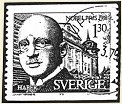"Suffocating" and "Acidic": The Major Components of the Air
The air we breathe consists mainly of nitrogen, namely almost four fifths, and about one fifths of oxygen. Here, we want to take a closer look at these two gases, which together make up more than 99% of the air.
Nitrogen
The elemental nitrogen as it is present in the air, is a colourless and odourless gas. It consists of molecules with the formula N2, where two nitrogen atoms are linked by a triple bond. This bond is very stable, therefore nitrogen is very slow to react under normal conditions.
No life is possible in nitrogen, and we would suffocate in pure nitrogen, lacking the vital oxygen. Its name is derived from Greek meaning soda forming.
 How Is Nitrogen Produced? How Is Nitrogen Produced?
Both nitrogen and oxygen are gained from the air. For this, the air is cooled down by the Linde process until it becomes a liquid. Since nitrogen and oxygen have different boiling points, they can be separated from each other and purified by distilling the liquefied air. The purified gases are sold in high-pressure gas-cylinders. Nitrogen in green cylinders, oxygen in blue ones.
What Is Nitrogen Used For?
 Since it is so slow to react, pure nitrogen is used as a cover gas for reactions with oxygen-sensitive substances in chemical laboratories. It is also used as protective gas for food packaging: By excluding the oxygen, the foods keep longer. Since it is so slow to react, pure nitrogen is used as a cover gas for reactions with oxygen-sensitive substances in chemical laboratories. It is also used as protective gas for food packaging: By excluding the oxygen, the foods keep longer.
However, the most important application of nitrogen is for the production of ammonia (NH3), which is required in huge amounts as an initial product for the production of fertilisers, paints and explosives. For the production of ammonia, the Haber-Bosch process is used, for the development of which the German chemist Fritz Haber received the Nobel Prize in 1918. In this process, the starting products nitrogen and hydrogen are brought to reaction with each other at an iron catalyst in a big reactor under high pressure and increased temperature.
Oxygen
 The oxygen of the air consists of molecules with the formula O2, where two oxygen atoms are linked by a double bond. Oxygen, too, is a colourless and odourless gas, but very reactive in contrast to nitrogen. The oxygen of the air consists of molecules with the formula O2, where two oxygen atoms are linked by a double bond. Oxygen, too, is a colourless and odourless gas, but very reactive in contrast to nitrogen.
Oxygen reacts with many other substances. Sometimes very brisk and even emitting flames – we know this as the burning of the substance - sometimes very slowly like rusting iron. In pure oxygen all reactions pass off more violently than in the air. In the former even iron burns with a bright flame (steel wool in the picture).
Reactions with oxygen take place in our body as well during metabolism. Because of this, oxygen is vital for us, and we have to take it in from the air by breathing. That it is diluted with nitrogen in the air is only for our best: Pure oxygen is very aggressive and damaging for our cells. In addition, in an atmosphere with pure oxygen there would always be a constant fire hazard.
Oxygen itself is not acidic, but it was formerly wrongly believed that it was the fundamental component of all acids, and therefore was called "oxygen", meaning "acid-former" in Greek.
What Is Oxygen Used For?
  For gas welding, the welding gas is burned in pure oxygen, as a result of which temperatures of up to 3000°C are reached. In space flight, the rocket fuel is burned with oxygen as well. For gas welding, the welding gas is burned in pure oxygen, as a result of which temperatures of up to 3000°C are reached. In space flight, the rocket fuel is burned with oxygen as well.
Naturally, oxygen is also required for respirators in medicine.
Larger amounts of technically produced oxygen are used up during steel production, where impurities in the pig iron are removed with the LD process by blowing pure oxygen into the pig iron.
|
 Air
Air  Suffocating and Acidic: The Major Components of the Air
Suffocating and Acidic: The Major Components of the Air

 Air
Air  Suffocating and Acidic: The Major Components of the Air
Suffocating and Acidic: The Major Components of the Air
